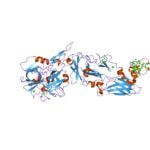It was once known as the disease that plagued royal families in the 19th and 20th centuries. Hemophilia B famously struck dynasties in England, Spain, Germany, and Russia, beginning with diminutive Queen Victoria, who ruled England from 1837 to 1901. The Queen’s life was depicted in the first season of a recent Masterpiece Theater series.
Queen Victoria’s parents had no family history of hemophilia, so she was likely a carrier due to a spontaneous mutation. She passed her mutation onto her son, Prince Leopold (a hemophiliac who died from his mutation at age 30 after a minor fall, but not before passing it along to his only daughter, Princess Alice of Albany), and to two of her daughters, Princess Alice and Princess Beatrice, who were carriers, who carried the mutation he mutation into the Spanish, German and Russian royal families.
Victoria’s granddaughter Alix married Tsar Nicholas, resulting in son Alexei. The child was executed at age 13 along with the rest of his family, but in 2009 his charred bones yielded DNA that revealed him to have the bleeding disorder.The last living relative of the lineage was Prince Waldemar of Prussia, a cousin of the ill-fated Alexei, who died as World War II was ending and blood supplies were sent to the emptying concentration camps. He was denied a transfusion.
Today, researchers are looking to genome editing to provide a more robust treatment option for the disease sufferers. And for at least one company, those efforts involve harnessing the power of albumin – the stuff of egg white and also the most abundant protein in blood plasma. Albumin controls fluid distribution in the body, but researchers can borrow it’s genetic controls to mass-produce selected proteins.
Sangamo Therapeutics is using genome editing to hitch the gene for the clotting factor that’s missing in hemophilia B (factor IX, aka FIX) to the controls of the albumin gene, rather than manipulate the FIX gene directly. And instead of using the media darling CRISPR-Cas9, it relies on an older, perhaps more controllable editing tool, zinc finger nucleases (ZFNs). The strategy works in mice, and a clinical trial is just getting underway, with FDA giving fast track designation to the company’s “SB-FIX in vivo genome editing treatment for hemophilia B.”
“Our ultimate goal is to treat children young enough so they will have a solution that will last for a lifetime and they will not have to face the consequences of the disease,” said Sandy Macrae, president and CEO of Sangamo. He calls the technology “beautiful Star Trek type science.”
Normally, in response to a puncture injury, the body stanches blood flow by knitting long, feathery strands of the protein fibrin into clots as the culmination of a cascade of interacting proteins, the clotting factors. FIX and factor VIII join in midway through the action. About 16,000 people in the U.S. have hemophilia A (factor VIII deficiency) and 4,000 have hemophilia B. Both genes are on the X chromosome, so males are affected and women are carriers.
From transfusions to gene therapy
I interviewed the first person to receive gene therapy for hemophilia A, in 2000. Born in 1949, Don Miller was raising sheep when he became the first participant in a clinical trial at the University of Pittsburgh, receiving the retrovirus-bound factor VIII gene on June 1, 1999. His story chronicles the evolution of hemophilia treatment. It began with nearly bleeding to death following his circumcision as a newborn.“When I was 3, I fell out of my crib and I was black and blue from my waist to the top of my head. One time I fell at my grandmother’s house and had a 1-inch-long cut on the back of my leg. It took five weeks to stop bleeding, just leaking real slowly,” he told me. After that he limited activities and had frequent transfusions – those were the days before AIDS, which would infect 90% of the people with hemophilia before screening blood donations began. Ryan White was a teen with hemophilia A who drew attention to the vulnerability of the hemophilia community and ended use of the word “hemophiliac.”
By the time Miller had married, in 1969, he was receiving gamma globulin pooled from donated plasma and frozen, pooled factor VIII, called “cryoprecipitate.” He got into the clinical trial because he’d managed to avoid the HIV infection that kept many people with hemophilia out: “I lucked out.”
It’s just one case, but Don Miller improved – he needed boosters of factor VIII (now made more safely using recombinant DNA technology) less frequently, he had no more spontaneous bleeding, and nosebleeds stopped within minutes – as they would for anyone with normal clotting.
Alas Mr. Miller’s good response had exquisitely poor timing, for 1999 was a tragic year for gene therapy. On September 17, 1999, the death of 18-year-old Jesse Gelsinger from an overwhelming immune response to gene therapy to treat a urea cycle disorder paralyzed the field. Also that year the first boys received gene therapy for an immune deficiency that used a retrovirus, which would cause leukemia two years later, again paralyzing the field.
But gene therapy re-emerged, with the hemophilias at the forefront. Ongoing hemophilia B clinical trials include those sponsored by UniQure Biopharma and St. Jude’s Children’s Hospital. Spark Therapeutics, in collaboration with Pfizer, recently announced preliminary data from 10 patients that showed persistent and sustained FIX production, although some patients needed steroids to quell a change in liver enzymes that could indicate an immune response. But on May 10, Dimension Therapeutics halted its trial for hemophilia B, citing “inability to achieve a minimum target product profile.” Sources tell me off-the-record that this means elevated liver enzymes that could signal an immune response.
Enter zinc fingers
Treating hemophilia B at the protein level costs $100,000 a year for “bleeds” and up to $250,000 if given two or three times a week to prevent bleeding. That’s about $20 million over a lifetime. Gene therapy seems a great alternative, a possibly one-time fix. The gene is small and only a small increase in the level of the clotting factor in plasma can make a big difference in how a patient feels.A report from 2014 charts the “Long-Term Safety and Efficacy of Factor IX Gene Therapy in Hemophilia B,” but the vector, a type of adeno-associated virus, deposits the FIX gene in an episome, which is a bit of DNA outside of a chromosome. Like peeing in the ocean, a gene added in an episome becomes diluted as the chromosomes duplicate as cells divide, but the episomes do not. Still, gene therapy might provide enough factor IX to help adults. But young children might be a different story. For them, genome editing might be a longer-lasting approach because it inserts the healing gene at a selected site in a chromosome.

A gene therapy or genome editing approach to hemophilia would eliminate the need for frequent infusions of clotting factor.
A zinc finger is a small protein that folds into an oblong shape when it binds zinc atoms, and it binds to a specific sequence of DNA found in about 3 percent of all human genes. A DNA-cutting enzyme attracted to a bound zinc finger forms a scissor-like molecular tool.
The power of zinc fingers comes from their natural affinity for transcription factor genes, which in turn encode proteins that control which suites of genes are turned on or off in a particular place and time. Zinc fingers were discovered in the African clawed frog in 1985, and first used as genetic switches in 1994.
Macrae explains how it works:
“We’ve designed zinc fingers to recognize intron 2 of the albumin gene, land on the DNA, and the restriction enzyme attaches, dimerizes, and cuts the DNA. At the same time as the ZFN cuts, we introduce a separate AAV with a good copy of the gene that encodes the missing protein.”Some of the targeted liver cells take up the cargo and then release factor IX, which makes its way to various tissues.
He calls use of the albumin gene a “’safe harbor’ because you don’t need all of the albumin you produce. It has nice introns where we can land it and we will never remove but a fraction of the albumin genes from producing albumin.”
Meanwhile, he and his colleagues at The company is also launching clinical trials to tackle two mucopolysaccharidoses (Hunter and Hurler syndromes), and has treated 100 people with HIV with zinc fingers targeted to the CCR5 gene. ZFNs can hit any target in the genome efficiently. “We think zinc fingers is the leading genome editing technology. But eventually there will be others, and CRISPR will sort out its problems,” Macrae said.Sangamo are looking forward to the day when zinc fingers can help the youngest patients with hemophilia B:
“Parents whose children have hemophilia B came to see us, and they talked about holding their babies down to find a vein in the scalp to give an infusion. Some patients need clotting factor on a daily basis, and getting it dominates their lives. Patients die. We see what we do as part of the journey to eventually offer patients a chance to address the disease in a fundamental way.”


No comments:
Post a Comment